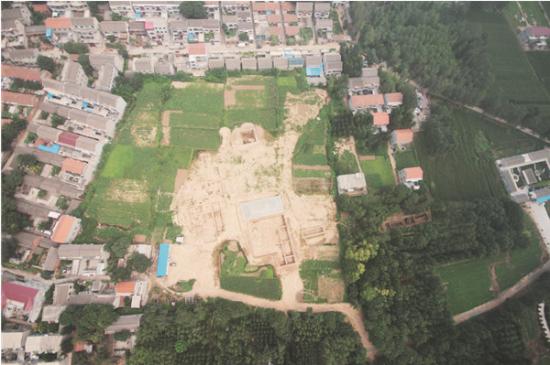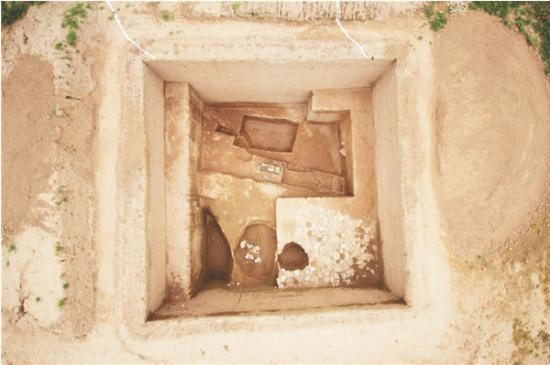Chinese Institute of Archaeology
Source - http://www.kaogu.cn/en/detail.asp?ProductID=3962
Liyang Storage was one of the profound commissariat storages during the Sui Dynasty. It was regarded as a resource-supplying base for the back when Emperor Yang of Sui Dynasty wanted to manage the northeastern border.
In order to facilitate the nomination of the Grand Canal (also known as Yongji Canal in Sui and Tang Dynasties) as a World Heritage Site, an archaeological investigation and survey was conducted from October 2011 to present by the Henan Provincial Institute of Archaeology with the collaboration of the Jun County Tourism Bureau. The archaeological works concentrated on the possible location of Liyang storage site – Chengguan Town of the Dongguancun village at the Dongguantunshang site. Situated in the northern lower hillside of the Dapi mountain and away from provincial road 215 around 600 meters to the east, the site was later confirmed as the Liyang storage site. Features identified in the Liyang storage including the fortress wall, moat, rammed earth foundation, storage feature, huge construction base foundation, path, burials, ditches as well as ash pits.

The archaeological excavation of Liyang Storage site was started from December 2011 and 2800 sq. meters have been excavated. Features identified including the fortress wall and moat of the Liyang Storage, features from 3 Sui and Tang Dynasties storages, ditches (southern portion) used during the Sui and Tang Dynasties, 11 burials from various periods, 100 ash pits, 1 path, 15 stoves and two huge construction base from the Northern Song period.
The Liyang storage was built along the hill in rectangular shape measured 260 meters from east to west and the remaining length from south to north was 300 meters. The perimeter was around 1100 meters. The wall of the fortress was made of rammed earth with 0.10-0.15 meters thick and the thickest portion was around 0.20 meters with a diameter measured 0.05 meters. Due to the slanting location of the Liyang Storage, the fortress wall has been modified with rammed earth in the vicinity. The northwestern corner of the northern wall was relatively well preserved with a remaining width around 6.2 meters and 1.5 meters remaining height. With the excavation of the east fortress wall running from northeast and southwest directions, the wall was away from the ground 2.9-3.15 meters with a remaining width 5.5 meters after trench excavation. The moat located in the eastern wall measured around 3.5 meters with 3.9 meters wide. Two sets of concentrated postholes were identified from the bottom of the moat and ditch. The diameter of the posthole measured in between 0.12-0.18 meters. Further examination is required to confirm whether these postholes were related to the wooden bridge feature. Another moat was identified away from the outer east wall. Two burials from the Five Dynasties and Northern Song respectively were identified in the Song / Jin cultural layer between the east fortress wall and moat. Thus, it is believed that the fortress wall and moat were already abandoned during the Five Dynasties.

A nullah feature was running from south to north was identified in the north central area of the storage fortress and the opening was measured 8 meters wide, in which the context was identical to the storage. A number of broken walls were also identified in the southern end of the nullah. A rammed earth terrace was unearthed in the northwestern section of the nullah measured 40 meters in length from east to west and 25 meters in width from north to south. Judging from the layout of the storage, the northwestern part of the fortress is the best location for water and land based grain transportation and management office.
At present, 84 circular storages with huge opening and small bottom are identified. The diameter of the opening was different with the smallest measured around 8 meters and the largest measured 14 meters, most measured around 10 meters. The base of the storage was away from the ground from 3.8 to 7 meters. The sequence of the storage was in a clear order with 7 sets aligned from north to south in west eastern alignment and each set has 10 storages. Each set was 10 meters apart from each other. The storage measured 3.5 (closest) to 10 meters (farthest) away from each other. Most of these storages measured 6 meters away from ground with some over 7 meters.
The diameter of the three excavated storages dated Sui Dynasty (No. C6, C16 and C18) was around 8 meters. Several circular and rectangular column base features were identified near the storage opening. In accordance with the artifacts unearthed from the storage and the ground level construction features of the Northern Song, the Liyang Storage was probably being abandoned before the mid Tang Dynasty.
During the excavation in the central portion of the site, a large area of rammed earth construction feature was identified on top of the dumped storage remains of the Sui and Tang Dynasties. Two huge construction features merged from east and west were identified (Footings No.1 and No.2).
Footing No. 1 was located in the west central portion of the storage with 900 square meters exposed. The base feature ran from northeast to southwest and measured more than 50 meters from south to north with 12 meters wide measured from east to west. Thirty-eight column bases were exposed in circular or near circular shape. The diameter of these column bases was around 1.3 meters, the depth ranged from 0.38 – 0.50 meters and separated from 2.9-3.2 meters apart.
Footing No.2 was situated in the central part of the storage with 600 square meters. The footing aligned from northeast to southwest and 28 meters in length 25 meters in width was being exposed. Nineteen column bases were exposed together with 10 postholes. The column bases shaped in circular, near circular and rectangular while the diameter of the circular or near circular column base ranged from 0.9-1.3 meters. The length of the rectangular column base was 2.3 meters while the width was 2 meters. The smaller one measured 1.6 meters in length and 1 meter in width. Depth of all column bases was around 0.38 to 0.49 meter. Separating distance of footing No.2 was wider from east to west from 3 to 5 meters while narrow from north to south in around 3 meters.

Copious amount of bricks, tiles, roof figures and other construction materials were identified during the excavation of No.1 and 2 construction base features. Amongst those, almost a hundred of flat tiles inscribed with “Guan (Official)” character were identified and further confirmed the official nature of these structures.
The stratigraphy and characteristics of the unearthed artifacts, including a hundred of flat tiles inscribed with “Guan” character share the Northern Song characteristics. In this connection, it is presumed that the dating of the ground construction was belonged to the northern Song, which was the Liyang Storage architecture.
Two stages of development were identified through the existing research materials. For the first stage, which was an underground commissariat storage period, fortress and storages were built in early Sui Dynasty and was abandoned around mid Tang Dynasty or even earlier during the early Tang Dynasty. The second stage was the aboveground commissariat storage; the storages were being built in early Northern Song Dynasty and were abandoned during the late Northern Song Dynasty. Further examination is required to confirm if a fortress has been built. The construction and existence of the storages in these two stages have a strong connection with the Yongji Grand Canal (known as “Emperor Canal” during the Northern Song Dynasty).
While archaeological excavation was conducted in the Liyang Storage Site, investigation and survey were also conducted in the Liyang City Site at the same time away from the Liyan Storage site about 600 meters from east. It was the first time the location and the proximity of the ancient Liyang City being confirmed. A connection can be further established between the Liyang Storage Site and the Liyang City. The wall of Liyang City measured 2,250 meters in length from north to south and 800 meters from east to west in width with an area around 2,000,000 square meters, which is exactly the same with the historical records mentioned about the Liyang Storage Site and Liyang city. From the investigation, large number of celadon porcelain dated from Tang and Song Dynasties were found and provide material proof for the city site dating. The investigation and survey of the Liyang City provides important evidence to proof the Liyang City and Liyang Storage Site as one entity in accordance with the historical records.
The archaeological discoveries in Liyang Storage site provide valuable evidence for the nomination of The Grand Canal (Yongji Canal) in the Sui Dynasty as a World Heritage Site in terms of the canal excavation and manipulation. The excavation further explained the prominent strategic values of the Yongji Canal during the Northern Song period as to fortify the northern border. In addition, the excavation also provides new archaeological data for the ancient official commissariat storage in terms of the construction and commissariat storage techniques. The data also verified the historical records on Liyang Storage site meanwhile providing fundamental materials for the protecting the site effectively.
Translator: Andy Yiu